Teens can be very self-conscious about their looks and might be curious about teeth whitening options available to them.
A bright and sparkling smile can boost a teenager’s confidence significantly. However, as parents, you might be concerned about the safety of teeth whitening for teens and wondering at what age it is appropriate.
Teeth whitening can be a safe and effective way to improve your appearance and self-esteem without undergoing any invasive procedures. A whiter smile can be achieved in a short period of time with the proper treatment.
Although teeth whitening for teens is not recommended until they have all their adult permanent teeth (usually between 14-16), there are options for younger teens and tweens who’d like to remove stains on their teeth.
You might also like to read: Can Dentists Tell If You Vape & Will They Tell Your Parents?
Is Teeth Whitening Safe For Teenagers?
Generally, teeth whitening is safe for teenagers if done correctly. There are essential things to keep in mind, and it’s important to understand the risk and possible side effects of applying teeth whitening products.
Teeth whitening is only recommended for teenagers once they have all their adult teeth. On average, teens will usually have all their adult teeth between 14-16 years of age.
Patients whose adult teeth are in healthy condition can undergo teeth whitening. Those with thin enamel, infection, or advanced decay may not be the best candidates for teeth whitening products. Below are more contraindications where tooth whitening is advised with caution:
- Allergy to peroxide
- Pre-existing sensitive teeth
- Cracks or exposed dentine
- Enamel development defects
- Acid erosion
- Receding gums (gingival recession) and yellow roots
- Sensitive gums
- Defective dental restorations
- Tooth decay
- Active periapical pathology
- Untreated periodontal disease
- Pregnant or lactating women
- Children under the age of 16. This is because the pulp chamber, or nerve of the tooth, is enlarged until this age. Tooth whitening under this condition could irritate the pulp or cause it to become sensitive. Younger people are also more susceptible to abusing bleaching.
- Persons with visible white fillings or crowns. Tooth whitening does not change the color of fillings and as such, a shade mismatch may be created as the natural tooth surfaces increase in whiteness and the restorations stay the same shade.
- Individuals with poor oral hygiene
Source: Wikipedia
If your teen has any of these conditions, then tooth whitening might not be advised, and you should contact your dentist first.
For teens with healthy permanent adult teeth, there are several teeth whitening options available, from OTC (over-the-counter) strips, gels, and kinds of toothpaste that you can use at home, to in-chair treatments performed by a dentist.
When performed under a dentist’s supervision, teeth whitening is safest for teens. A dental professional will perform and monitor the procedure to ensure that safe practices and products are used.
A dentist can properly fit a custom-made bleaching tray for safe and effective teeth whitening. Unless properly handled, these materials can damage existing fillings and crowns or cause sensitive teeth and gums.
In most cases, tooth sensitivity occurs after teeth whitening, but it usually clears up within a few days. If you know that your child has sensitive teeth, inform the dentist beforehand.
Teeth Whitening Options for Teens
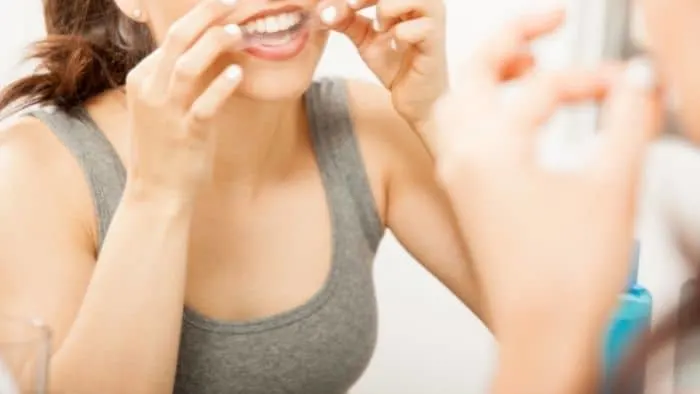
If your teen wants to whiten their teeth, there are many options available.
Teenagers can brighten their smiles through professional treatments in as little as one visit. There are also simpler at-home methods that work well.
Before investing in one of the following teeth whitening options, teens must have good oral hygiene first. This includes:
- Brush teeth twice a day and after consuming food or drinks that can stain their teeth.
- Avoid drinks that can stain their teeth (soda, tea & coffee).
- Visit a dentist regularly for a deep tooth cleaning.
Teenagers have several options for teeth whitening, including:
Baking Soda
Baking soda is a natural home remedy for whitening teeth. You can use bicarbonate of soda (or baking soda) to brush your teeth a couple of times a week. As it is a very mild abrasive, you can use baking soda to help whiten their teeth naturally without harming their tooth enamel. Baking soda works in lightening acid-based food stains from coffee and tea, but it won’t bleach your teeth.
Whitening Toothpaste
It is far more gentle to brush with a mild whitening toothpaste than to use bleaching products.
While bleaching alters the color of the teeth, whitening toothpaste contains mild abrasives or polishing agents that will only remove surface stains.
Teens can use a whitening toothpaste as part of their regular oral hygiene routine (brushing and flossing), and they should see results within three months.
Using a whitening toothpaste will also extend the results of other whitening treatments they may have had.
Whitening Strips
If a stronger whitening agent is needed, you could look at OTC products like whitening strips, trays, and paint-on gels.
Commercial whitening strips typically have a hydrogen peroxide concentration between three and 13 percent.
Since drugstore products contain a lower concentration of the same bleaching agents dentists use, they are safer to use at home.
Please note that even though peroxide is safe to use in low concentrations by adults, it is still a chemical and therefore not recommended for use by anyone under 12 years old.
You can purchase whitening strips over the counter, and they should be applied to your teeth once a day or twice a day. The length of time that you should leave the strips on your teeth will depend on the product’s strength. This can range from 5 minutes (for higher concentrations of bleaching agent) to 45 minutes for weaker solutions. Some should be used for one week, while others might require you to apply for a month.
Always read your teeth whitening instructions carefully and follow the directions for best results.
Do not leave teeth whitening strips on your teeth for a more extended period of time than recommended on the product instructions.
Hydrogen peroxide, a bleaching agent, is commonly found in these products. While it is safe to use, caution should be exercised as overuse may result in gum irritation and teeth sensitivity.
Always consult your dentist first if you have sensitivity, cracks, loose dental work, or unfilled cavities.
Teeth Whitening Trays and Gels
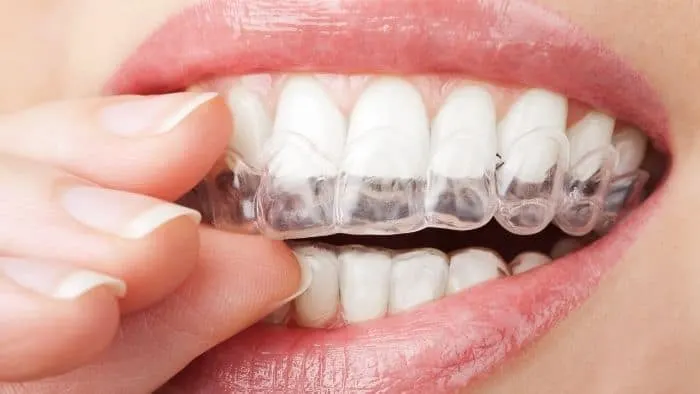
Gel trays can be used to brighten teeth with deeper stains more rapidly. While over-the-counter gel trays are becoming more and more popular, you may not be able to get the best results with over-the-counter products without a custom-fit tray
With custom-made whitening trays, you can ensure that the treatment is personalized and will yield excellent results.
An impression taken in a dentist’s office will be used to make dental trays, and a whitening gel with professional strength will be used to whiten your teen’s smile.
A benefit of using a custom-fit dental try is that you can use less product, and the product will be less likely to come into contact and damage your gums.
Whitening trays for children can be cleaned with cold water and a soft toothbrush.
The manufacturers recommended mouthwash, diluted mouth rinse, and toothpaste. When it has dried, store it in a sturdy container until it is needed again.
LED Light Activated Teeth Whitening Kits
LED blue light treatments are becoming increasingly popular due to their perceived safety over UV light.
In addition to using a whitening gel on your teeth, you will also use a blue LED light which activates the peroxide in the gel, and helps lift stains off your teeth faster.
Whitening products that include a blue light are available over-the-counter, or you can visit your dentist for treatment.
Although there are mixed reviews on whether the blue light actually speeds up the whitening process, it is considered a safe option if performed correctly.
Professional In-Office Tooth Bleaching

A dentist’s in-office bleaching procedure provides long-lasting results. In as little as one hour, teenagers can see results from a single session.
For immediate and lasting results, certain whitening gels can be activated with a special medical laser.
With the use of professional-grade products, a dramatic improvement will be noticeable immediately. Your teen’s teeth will be significantly whiter after just one session.
Teeth Whitening Maintenance
Depending on what you eat and your oral hygiene routine, stains can return, so it’s best to follow a maintenance routine to prolong your treatment results:
- After the whitening procedure, take extra precautions during the first 24 to 48 hours – this is the time when you must protect your teeth the most. Hence, it is vital that only non-staining drinks or foods are eaten during this time as enamel is prone to adhere to stains.
- Drink fluids that may stain through a straw.
- Depending on the method used to whiten the teeth, re-treatment may be required every six months or after a year.
- In-office teeth cleaning will help keep your teen’s smile bright and white.
What is the Ideal Age for Teeth Whitening?
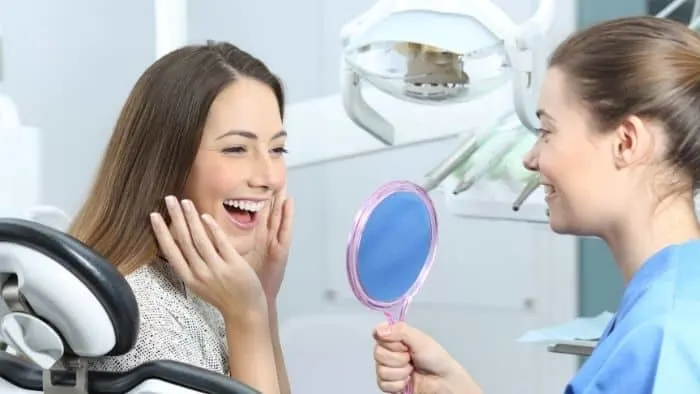
Whitening the teeth can be done at any time once patients have all their adult teeth.
In general, dentists recommend teeth whitening take place no earlier than 14 years of age, when all the permanent teeth are in, as primary teeth tend to be more vulnerable than permanent teeth.
When the tooth pulp is fully formed around the age of 14 to 16, teeth whitening will result in less sensitivity.
The right age for teeth whitening depends on your teen. If you have any doubts about the responsibility of following teeth whitening instructions on your teenager, you should wait until you are confident they can handle it or manage it under strict parental supervision.
How Can I Whiten My 13-Year-Olds Teeth?
As most 13 years old won’t have all their adult teeth yet, teeth whitening with peroxide is not recommended.
However, they can brush their teeth with a little bit of baking soda, or use teeth whitening toothpaste a couple of times a week.
Ensure that they brush their teeth twice a day for a couple of minutes, and remove all the plaque as plaque can stain teeth.
They should rinse their mouth after consuming anything that could stain their teeth (i.e. colored soda), and chew xylitol gum if they cannot brush immediately.
Consult your dentist if you’re not sure of the cause of your child’s tooth discoloration and need professional treatment.
Teeth Whitening Risks For Teens
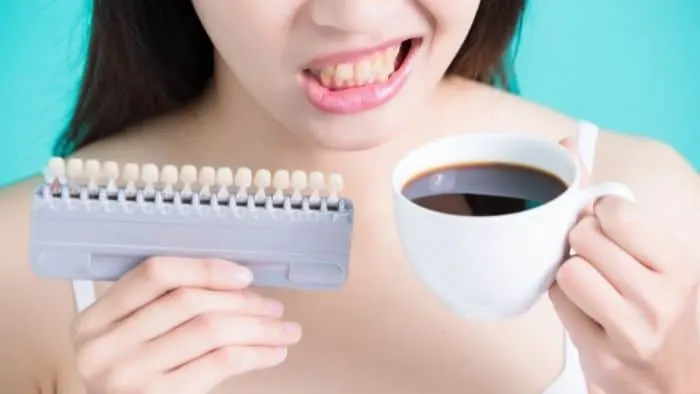
Most teeth whitening products such as strips, gels, and pens contain hydrogen peroxide solution as a primary ingredient, posing potential risks to kids and teens. Most of these whitening treatments contain hydrogen peroxide in concentrations of up to 13%, and the higher the concentration, the greater the risk of adverse effects on young teeth.
If the gel is left on too long, it can dehydrate the tooth and increase sensitivity.
In contrast to permanent adult teeth, primary or baby teeth have thinner enamel and dentin and a larger pulp (the living tissue inside the teeth).
Even though teeth whitening is safe if done correctly, teeth whitening products can easily be misused by teens.
Without adult supervision, teens might use these products incorrectly and have the following consequences:
- If the strips are left on for much longer than instructed, or if the strips are applied more frequently than suggested, they can cause significant tooth sensitivity and irritation of the oral tissues.
- Dentin may demineralize.
- Variation in tooth color could occur.
- The enamel may pit and disintegrate.
- It could lead to injured pulp nerves.
- If the strips are inserted onto the gums, it can cause gum irritation and even gingival (gum) damage.
Parents should always ensure that their teens follow the manufacturer’s instructions and ask their dentist for professional advice.
Tips on Keeping Your Teen’s Teeth Bright and Healthy
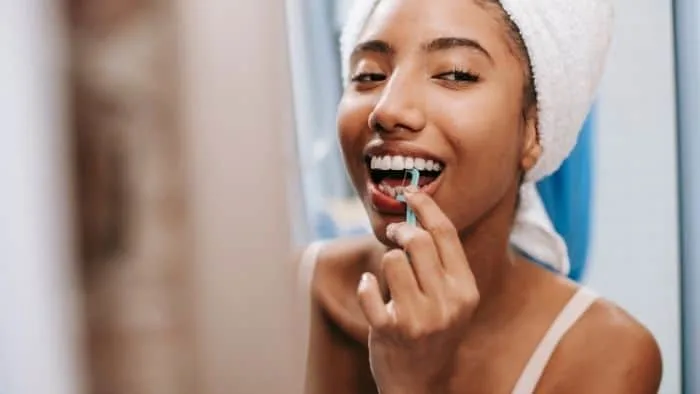
The stains on our teeth can come from the inside, from the outside, and sometimes from both sources simultaneously. Various factors cause teeth stains, including food and drinks like pasta sauce, berries, curry, balsamic vinegar, coffee, and dark teas.
Your teen can prevent staining as they age by limiting the consumption of these items and rinsing their mouth after consuming them.
Xylitol gum is also a great option to clean your teeth when you cannot brush them. Xylitol inhibits the growth of bacteria and helps fight plaque. As plaque absorbs stains, chewing xylitol gum will help prevent plaque build-up and staining your teeth.
It is best to maintain a daily oral routine and stay well hydrated to prevent stains.
It is also imperative for your teen to remember to floss and brush around orthodontic appliances. Trapped food particles can lead to discoloration and decay between braces and teeth.
Your teen’s smile will remain healthy for many years to come if they continue to practice proper oral hygiene habits.
Summary

Considering teeth whitening for your teenager might be a great choice that gives your teen a whole new level of confidence.
There are pros and cons to both home and professional whitening methods. You might be reluctant to allow your teen to whiten their teeth, so it is best to consult with a trusted dentist before starting any teeth-whitening treatments for your teen. Your dentist will review your teenager’s records to determine the most efficient and effective method for teeth whitening.
Generally, professional methods are stronger and longer-lasting than OTC products. They are also more effective at whitening teeth with deep, intrinsic stains. The method to use will vary based on the stain type and your overall diet. A dentist may recommend surface bleaching, prescription products, and frequent deep cleanings in some cases.
Make sure your kids have realistic expectations about the results before starting any whitening regimen. It is common for teens to be impatient and expect immediate results, which can lead them to abuse and overuse whitening products. Excessive use of these products can cause tooth sensitivity.





